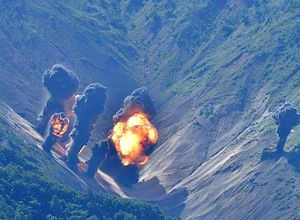On August 30, one day after North Korea carried out its first-ever overflight of Japan with a ballistic missile designed to carry a nuclear weapon, the United States, Japan, and South Korea staged a massive show of force involving several aerial assets.
U.S. Marine Corps’ F-35B Lightning II fighters, for the first time, joined U.S. Air Force (USAF) B-1B Lancer conventional bombers, Republic of Korea Air Force (ROKAF) F-15K Slam Eagle fighters, and Japanese Air Self-Defense Force (ASDF) F-15J Eagle fighters for an exercise over Japanese and South Korean airspace.
A press release from U.S. Pacific Command spokesperson Cmdr. David Benham noted that the “mission was conducted in direct response to North Korea’s intermediate-range ballistic missile launch, which flew directly over northern Japan on August 28 amid rising tension over North Korea’s nuclear and ballistic missile development programs.”
The exercise was the first to involve U.S. B-1B Lancer bombers based at Andersen Air Force Base at Guam — the target of recent North Korean threats in mid-August. The last time the U.S. flew B-1Bs to the Korean peninsula was in early August. North Korea perceives the B-1B to be a nuclear-capable bomber despite its conversion for conventional payloads only.
“North Korea’s actions are a threat to our allies, partners and homeland, and their destabilizing actions will be met accordingly,” said Gen. Terrence J. O’Shaughnessy, commander of U.S. Pacific Air Forces.
“This complex mission clearly demonstrates our solidarity with our allies and underscores the broadening cooperation to defend against this common regional threat. Our forward-deployed force will be the first to the fight, ready to deliver a lethal response at a moment’s notice if our nation calls,” he added, according to U.S. Pacific Command.
The United States emphasized the involvement of F-35 fighters in the August 30 exercises. “The F-35 embodies our commitment to our allies and contributes to the overall security and stability of the Indo-Asia Pacific region,” said Lt. Gen. David H. Berger, commander of U.S. Marine Corps Forces in the Pacific.
“By forward-basing the F-35, the most advanced aircraft in the world, here in the Pacific, we are enabling the Marine Corps to respond quickly during a crisis in support of Japan, the Republic of Korea, and all our regional partners.”

































